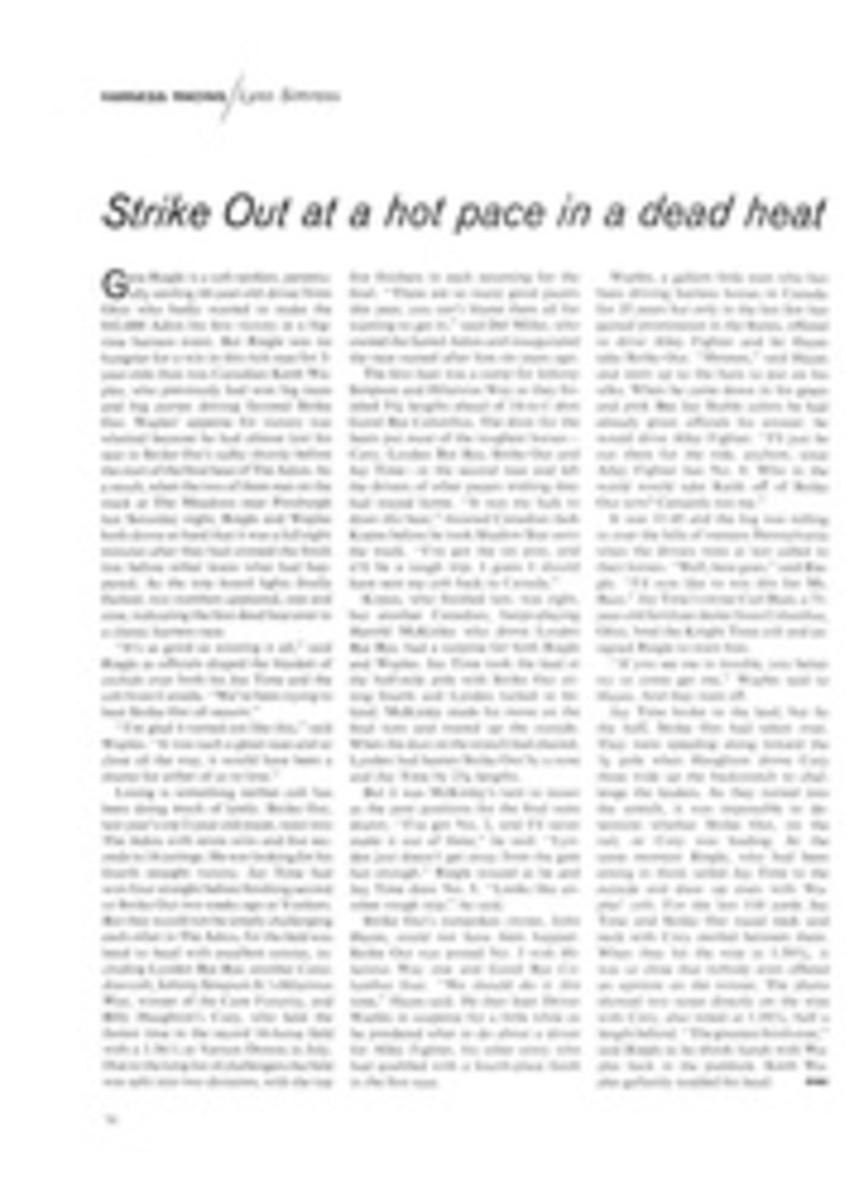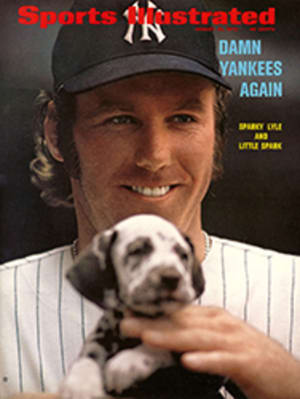
SCORECARD
100% FOR MARVIN
The continued predominance of stand-pattism in major league baseball manifested itself once more during the summer meetings in Kansas City last week.
The most radical proposal that came under consideration was the realignment of teams, either in four six-team leagues or three leagues of eight teams each. By the meeting's end, such proposals seem to have been buried all but permanently. Few club owners were enthusiastic for realignment. Even so progressive a newcomer into the ranks as Ewing Kauffman of the Kansas City Royals opposed it. suggesting instead that for the time being ailing franchises (his own has lost several millions in its four years) be encouraged to try for "better merchandising" of games. Kauffman, nevertheless, was one of a minority of owners willing to let his team play three games in New Orleans' domed stadium, as part of a plan by which 10 teams would play three games each there during a given season.
As usual, there was more support for realignment among American owners and club officials than among those in the more flourishing National League. Such owners and officials as Calvin Griffith of Minnesota, Dick O'Connell of Boston and Jerold Hoffberger of Baltimore all advocated realignment. The only National man in strong agreement was William Bartholomay, president of the Atlanta Braves, though he feared the reaction of Atlanta fans if their team ended up in a league or division with "northern" in its name. Instead of realignment, Spec Richardson of the Houston Astros urged everyone to "roll up their sleeves and go to work" to promote baseball. Pittsburgh and Cincinnati representatives also spoke out against the proposal.
But the real deathblow probably came from Commissioner Bowie Kuhn, who said his study of baseball law indicated that realignment probably could be accomplished only by unanimous vote, since it would involve disbanding present leagues and establishing new ones. And, as Joe McGuff, Kansas City Star sports editor, put it, about the only unanimous vote to be expected from major league owners these days would be to deport Marvin Miller.
WATER CURE
In the past 10 years there have been some 50 deaths from heatstroke in American football. All could have been prevented, according to an angry Dr. Robert Murphy, team physician for Ohio State University and a leading figure in an American Medical Association research group that has been addressing itself to such problems. Last week there was another heatstroke death. Mark Valentine, a 17-year-old Kenton (Ohio) high school football player, died in Columbus University Hospital.
"The coach had the football candidates run a two-mile course," Dr. Murphy reported, "and the boy collapsed after running it in something under 12 minutes. This is the most ridiculous thing you can do in preparing heavy interior linemen for football. To run a distance race to prepare for football doesn't make any sense at all. For the thin trackman, perhaps this is O.K., but for the heavy interior linemen it's disgusting. And virtually every one of our heat death victims have been linemen—the guards, centers and tackles, boys carrying too much weight."
Dr. Murphy's prescription: "Bring back the old-fashioned water buckets and throw away those salt tablets.
"Sweat is basically water," he explained. "Some salt, but mostly water. It compounds the problems if you take salt tablets and don't take water, but it's hard to get this point across to kids or coaches.
"If you replace water alone you'll never get in trouble. We are encouraging athletes to eat salt—after practice. We want them to salt food heavily and to use the electrolyte solutions (Gatorade and the like) to replenish salt. But in terms of preventing heatstroke, the important thing is to drink plenty of water before and during practice and I do mean plenty. Ten years ago we used to give players sips of water during practice and in time-outs during games. Now at Ohio State we average 100 gallons of ice water per practice.
"Coaches have told their players not to drink water because it makes you sick—and that's a lot of hooey."
THE WIDE WORLD OF MUNICH
The American Broadcasting Company, which likes to think of itself as "the innovative network," is distributing to its clients a guidebook entitled Munich and the Summer Olympics as Covered Exclusively by the ABC Television Network.
It is a good guidebook and includes such helps to the Olympic spectator as a complete program of the Games, a map, a brief dissertation on the city and lists of hotels, bars, beer halls, restaurants and nightclubs—even a glossary which advises that Eierfrucht means eggplant, Huhn is chicken and Rauchspeck is bacon. There is also a section entitled "Where to Meet Munich's Girls," and a warning against clip joints.
All very useful, no doubt. But then, as what might be considered a work of supererogation, there is a brief section headed "Ladies of the Evening," with directions on how to get to, for instance, "The IMEX House on Hohenzollern-strasse, two blocks west of Belgrad-strasse, on the right hand side, going out of town."
THE TIDE TURNS FOR SAM
The Hollywood-inspired view of the prizefight business is that it is a cutthroat racket without honor. In some times and places it has been just that—but not always or everywhere.
It has been a long time between big scores for Sad Sam Silverman, 59, who promoted 32 of Rocky Marciano's fights. And big scores came in only a few of the Marciano matches since 29 of them were put on in New England cities. Sam did make between $40,000 and $50,000 on one of the Sugar Ray Robinson-Paul Pender middleweight championship bouts in Boston in 1960. His last championship match was in 1962 when Pender and Terry Downes went at it in Boston. He almost had the Muhammad Ali-Sonny Liston bout in Boston, too, but Ali developed a hernia, and the fight drifted farther north to that one-punch show in Lewiston, Maine.
Now on Oct. 11 in Boston Garden, Sam looks to have another big score when George Foreman and Oscar Bonavena met for something called the Pan-American heavyweight championship. Sports Action made the match, and the reason it ended up in Boston with Sam cut in on a promoter's share goes back a few years.
In 1950 Dick Sadler, now Foreman's manager, arrived in Boston—broke and with three boxers in tow.
"I never knew Dick before," Sam says, "but I fixed him with a place to stay and eating money and got fights for his boys."
When Sadler left town a couple of years later he still owed Silverman money.
"He kept telling me he'd do something for me," Sam said.
Now Dick has paid off with two Foreman fights for Sam, one of them tentatively scheduled for Sept. 16 against an as-yet-unscheduled opponent, and the Bonavena match.
Sports Action made the two fights, but at Sadler's insistence Sam Silverman was included as promoter.
It's a plot that never will make a movie.
PEPE GOES TO STUD
On summer weekends in Murillo, a village in the heart of Spain's grape belt, there is ordinarily little to do except, appropriately, sip wine and bask in the sun. Change is setting in now, though, because hordes of tourists are invading the little town each August to watch the International Snail Races.
In this year's second annual meet, 74 escargots from eight countries challenged the one-meter, 20-centimeter course. After five agonizing minutes Spain's Pepe dashed across the finish line a winner, four lengths ahead of an obscure French snail which had obviously been detained by wine spilled on the track.
During the postrace victory fete there was more wine and plenty of snails to eat. But champion Pepe's owner decided to spare him, perhaps for breeding purposes.
JOURNEY'S END
Two biologists from the New Hampshire Fish and Game Department found a bottle in the Pemigewasset River. In it was a note signed by 16-year-old Jenifer Wilson of Bristol, N.H.
"Pick up this bottle to help stop pollution," the note said. "That's the least you can do for the water that has supplied you and your family for generations. If you don't, 20 years from now you and your family behind you will be in serious danger."
The bottle had been in the river for two years and Jenifer was surprised that it had been found.
"I figured it would be out in the ocean long ago," she said.
But the bottle had traveled only 15 miles downstream. It got hung up in some trash.
FREEDOM IN MUNICH
That psychedelic symbol designed for the 1972 Olympics is not a spiral, as it might seem to be after staring at it for a bit, but a Strahlenkranz.
A Strahlenkranz is a wreath of rays, a sunburst motif symbolizing outward expanding energy, a discarding of conventions, freedom. It has been linked to what Munich hopes the Olympics will be: heitere Spiele, or gay, carefree, happy games. The colors are those of the city itself—either azure blue on white, or white on azure blue, azure choose.
The symbol's designer, Ottle Aicher, head of the Ulm design studio and founder of Ulm's Design Institute, has good reason to wish for carefree freedom. He narrowly escaped execution by the Gestapo for his part in the 1944 anti-Nazi students' plot.
THE PELOTA MYSTERY
A crisis has developed in jai alai's supply lines. As matters stand at the moment, there will be no more American-made pelotas, which are the world's best.
For about four years now, Mrs. Isabelle Fernandez of Hialeah, Fla., a Cuban housewife, has been turning out an average of one pelota a day. She was the only producer of the little $30 ball for three Florida frontons—Orlando, West Palm Beach and Miami. Now she has decided to retire.
"It was the best pelota we have ever found," said Gordon Hulbert, head man at the Orlando-Seminole fronton, "and we have tried them from Spain and Mexico and other places."
He has enough of the Cuban exile's pelotas on hand to last two more seasons, Hulbert said, then will turn to other, though inferior, sources.
Mrs. Fernandez professes to have a secret way of making the balls, but, when Hulbert suggested he might buy the secret from her, "she mentioned a figure in the neighborhood of Joe Namath's new contract with the Jets."
"Why, we wouldn't use that many pelotas in 30 years," he said.
Mrs. Fernandez learned her secret from her father, Isadore Milan, who in pre-Castro years was known as Cuba's most skilled pelota maker. Now, if she goes, the secret goes with her.
ILLUSTRATION
THEY SAID IT
•Abe Gibron, coach of the Chicago Bears, on how he communicates with Mirro Roder, a Czechoslovakian place-kicker who speaks no English: "When I holler, he runs. When I blow my whistle, he runs. That's all he's got to know."
•Yogi Berra, Mets manager, after receiving a check made out to "Bearer" for his appearance on Jack Buck's pre-game show in St. Louis: "How long have you known me, Jack? And you still don't know how to spell my name."
•Frank Howard, retired Clemson football coach, on how much softer he was than his old coach, Wallace Wade: "Coach Wade would give his captain 10 laps if he lost the coin toss."
•Jerry Heard, pro golfer, on growing respect from his fellow members on the tour: "It used to be when I saw Palmer he'd just look at me and smile and say, 'Hi.' Now he sees me and says, 'Hi, Jerry.' "
•Karl Douglas, on his unshattered appearance after a poor performance at quarterback in the Colts' preseason game with the Redskins: "I try not to take life too seriously. You're not going to get out of it alive anyway."

